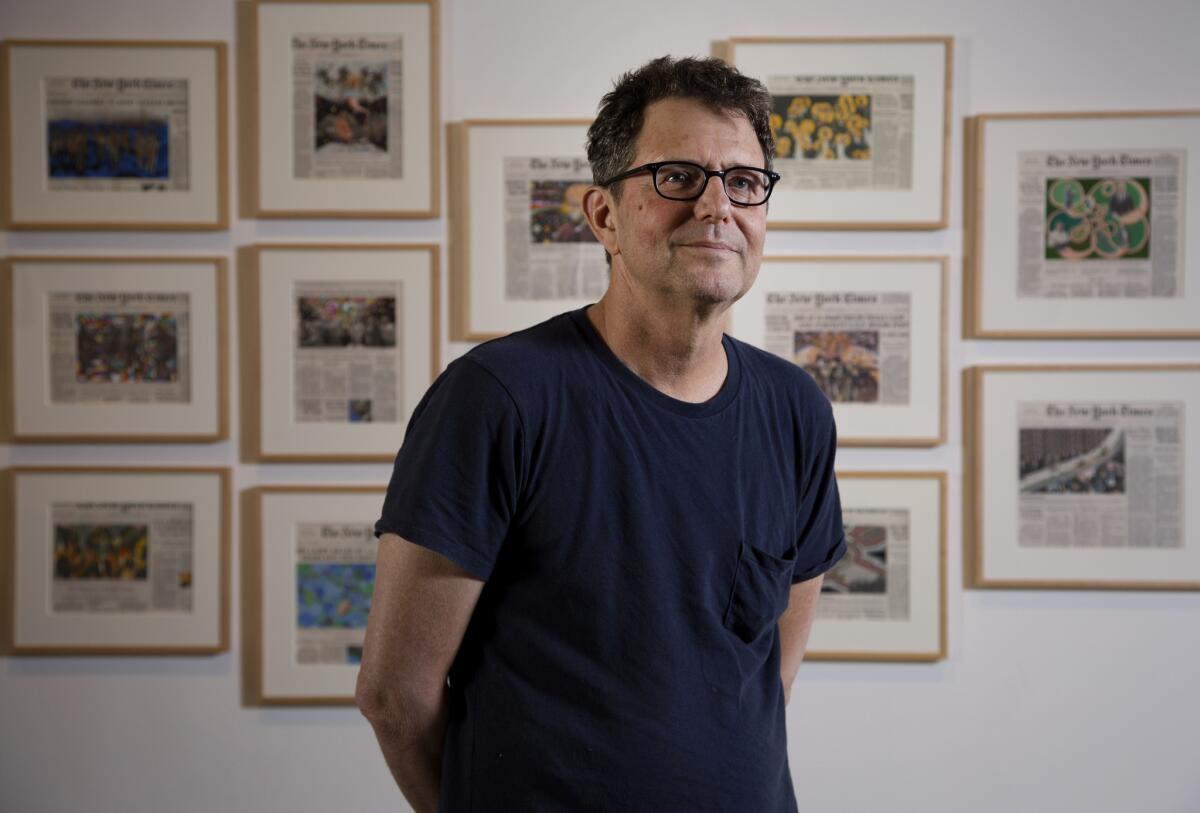Why artist Fred Tomaselli talks back to the New York Times

- Share via
In March of 2005, artist Fred Tomaselli picked up his morning copy of the New York Times and found a blaring headline about ex-WorldCom CEO Bernie Ebbers being convicted of an $11-billion fraud. The story was sensational — about the worst of Wall Street chicanery and excess. But what truly caught Tomaselli’s attention was the accompanying photograph: Ebbers staring at the camera in horrified shock; his wife, holding his hand, looking bleary and dazed.
“I couldn’t get the photo out of my head,” Tomaselli says. “Around that time, I had been working on some stuff related to Masaccio’s ‘Expulsion From the Garden of Eden.’ When I saw the photo, the first thing I thought of was how much it reminded me of the painting.”
Masaccio’s early 15th century fresco shows Adam and Eve in the traumatic moment they were shut out of paradise. Adam clutches his face. Eve covers her naked body in shame — her face bearing the agony of someone who has just lost everything. Tomaselli says he saw a parallel between the biblical tale and the story of the deposed Worldcom CEO.
“In a funny way, these people are also being shamed,” he says. “But their clutching hands made them human. He’s a suffering human being, even if he’s terrible.”
Enthralled by the picture, Tomaselli took the paper with him to the studio and proceeded to paint right on top of it. To Ebbers’ head, he added a hallucinogenic explosion of eyes and dots. Around the pair’s hands, he placed an aureole — the abstracted, golden flames that are used in the depiction of holy figures in Catholic iconography.
“It’s like, to deal with it, I started to draw all over the paper,” he explains.
That off-the-cuff drawing — titled “Guilty” — launched an entire series of works that the artist continues to make to this day. Over the last 10 years, Tomaselli has produced dozens of manipulated New York Times front pages: drawings that take journalistic photographs and turn them into joyous abstract patterns and mournful riffs on death, not to mention regular jabs at politicians — such as the image in which he’s painted over a cluster of smug-looking congressmen so that they appear to be naked.
“I get to talk back to the Times,” he says and laughs. “I get to be an editor!”
This Sunday, several dozen of the artist’s New York Times pieces go on view in Tomaselli’s first solo exhibition at the Orange County Museum of Art (OCMA) in Newport Beach.
The show, he says, rather mischievously, is “a return to the scene of the crime.”
Tomaselli lives in New York City — he’s been there since the mid-1980s — where he has made a name for himself as an artist, exploring the nature of perception in wild paintings and collages that include everything from pictures to pills. (He is represented by the prestigious James Cohan Gallery and he’s had one-man shows at various institutions around the country, including the Brooklyn Museum in New York and the Modern Art Museum in Fort Worth.) But the artist is 100% a product of Southern California: born in Santa Monica and raised in Santa Ana, with a pit stop in La Puente in between.
A boyish-looking 58 — with hair that has barely been touched by gray — Tomaselli is the son of a Swiss mother (who died more than a decade ago) and an Italian father, a retired draftsman who still lives in the Orange County house that the artist grew up in during the 1970s.
Tomaselli’s childhood was a very California mix of surfing and punk music — of hitting the waves in Newport Beach and record shops like Licorice Pizza in Costa Mesa and Zed in Long Beach (both now defunct). In between, there was plenty of pot smoking.
“I was a pain in the ass,” he recalls. “A stoner kid with a lousy grade point average.”
But Tomaselli says he always knew that he was going to be an artist. As a kid, he’d escape to the garage where he kept a mad-scientist lab full of scorpions and tarantulas. Away from the chaos of his family (he has five younger brothers and sisters), he would while away the hours making drawings, surfboards and more. It was in this workshop that he first started working with resin, used in the fabrication of surfboards — a material he uses to this day. (His paintings are often encased in lustrous coats of resin.)
Orange County also provided him with his most formative art experiences.
“The first museum I ever went to see art was the Newport Harbor Art Museum,” says Tomaselli of OCMA’s precursor. “It was a Llyn Foulkes show — those paintings of men with bloody heads. He really interested me because of the grotesque.”
And there was the installation he saw at UC Irvine by light and space artist Eric Orr (who died in 1998). “It was a ganzfeld,” he says — an environment that messed with the eye’s sense of depth. “The idea that what you see isn’t always what you get, well, it was pretty transformative.”
Despite bad grades in high school, Tomaselli graduated — “debt-free,” as he notes — with a degree in painting and drawing from Cal State Fullerton in 1982. Soon after, he moved to downtown Los Angeles, where he met up with other artists who were congregating around the area — figures such as performance artist Marnie Weber, painter Jim Shaw, the muralist Gronk and poet Marisela Norte.
To make a living, Tomaselli manned one of the few evening hangouts in downtown: the now-legendary Gorky’s Cafe and Russian Brewery, whose motto was “foodski, funski and brewski.”
“It was mainly homeless and the occasional artist,” he says of the restaurant’s customer base. Though, over time, Tomaselli was able to draw a regular crowd by booking bands and staging other cultural happenings.
Even so, the living was rough. “People kept saying that downtown was going to happen,” he says. “But it never did.”
In the early 1980s, the neighborhood was not the glossy magazine destination it is today. After nightfall the streets were generally empty and dangerous. On one occasion, Tomaselli says he was mugged and landed at what was then Los Angeles County General Hospital with a broken collarbone and several cracked ribs. On another, a good friend who lived in his building was repeatedly stabbed.
One night at Gorky’s, a homeless guy that went by the nickname of “Coffee-Free” — because he was always bumming free cups of coffee — tried to stab Tomaselli with a butcher knife. “Luckily a table full of chess-playing homeless guys saved me,” he says. “After that, Coffee-Free didn’t get coffee free anymore.”
In 1985, having lost his lease on his loft near the intersection of Ninth and San Julian streets, Tomaselli found himself at a crossroads: remain in L.A. or go someplace else. He settled on someplace else. Specifically, New York.
“I thought ... if I’m going to move, I’m going to move big!” he exclaims. “I’d never even visited New York, but I sold all my stuff and just went.”
More than a decade later, Tomaselli would become known for his fantastical painted collages, embedded with photographs and pills and the leaves of psychoactive plants such as cannabis. His works play with perception — often evoking the starry crackle of an acid trip — but also nature and pattern and the place of man in the cosmos.
The New York Times pieces, originally a departure from his usual work, have come around and begun to influence it — with images he creates for the newspaper collages reappearing in his larger paintings.
It was that process that interested OCMA chief curator Dan Cameron, who has known Tomaselli since the 1990s.
“I realized it was a fundamental shift in terms of who this artist is,” Cameron explains. “It’s a whole different approach to materials and content and form.”
When Cameron saw that the University of Michigan Museum of Art was planning a show of the New York Times pieces, he immediately agreed to take the exhibition on at OCMA — especially given Tomaselli’s roots in Orange County.
“For me, it’s thinking about how Orange County is something other than just a satellite of Los Angeles,” he says. “There are things about Orange County that we can frame and that make it part of the place that we’re in.”
The Orange County connection may not be immediately obvious when staring at cover after cover of the New York Times. (One hopes Tomaselli will have the good fortune to redecorate the Los Angeles Times too.) But it’s all there: the plays on perception the artist first encountered in that gallery at UC Irvine, the gross distortions he saw in Foulkes’ paintings at the old Newport Harbor, the trippy patterns inspired by wild drug trips out in the desert.
“These pieces,” says Tomaselli, “they’re daily facts of my life.”
“Fred Tomaselli: The Times,” opens Sunday 11 a.m. to 5 p.m., with an artist talk with Tomaselli from 1:30 to 2 p.m. It runs through May 24 at the Orange County Museum of Art, 850 San Clemente Drive, Newport Beach, ocma.org.
Find me on Twitter @cmonstah.
More to Read
The biggest entertainment stories
Get our big stories about Hollywood, film, television, music, arts, culture and more right in your inbox as soon as they publish.
You may occasionally receive promotional content from the Los Angeles Times.











